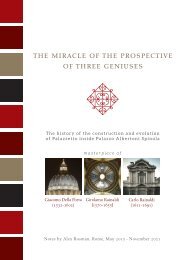PPP Business Plan 09 03
Create successful ePaper yourself
Turn your PDF publications into a flip-book with our unique Google optimized e-Paper software.
appraisal<br />
10 – A SEARCH FOR THE EVALUATION PARAMETERS FOR DIRECT PROCEDURE<br />
As Prof. Famularo stated as early as in 1942, as to the general principles of estimation: “from the<br />
logical point of view there is only one method to estimate the value of all goods, and that is the<br />
recognition that the given goods belong to a class of similar goods of a known price, based on a<br />
parameter which is common to all those goods” (Famularo, “Ancora sul concetto di dipendenza<br />
del valore dallo scopo della stima” / “Still on the concept of dependence of the value on the purpose<br />
of the estimation”, in Riv. Cadastre and SS.TT. EE., n. 2, 1942).<br />
These claims were, in principle, reformulated and shared by Prof. Marcello Orefice, who wrote:<br />
“Therefore, any estimative operation consists of the synthetic comparison between the goods being<br />
assessed and one or more groups of functionally similar goods, for which we have historical<br />
data about the prices that have already been applied in exchange operations.” (Orefice, Estimo /<br />
Appraisal, Utet, 1984).<br />
The retrieval of objective historical data to use for a comparison, can sometimes be tricky due to<br />
the constant habit of the persons involved in economics to reduce (often for taxation purposes)<br />
the actually agreed upon prices, although this phenomenon is declining as a result of the 2006<br />
Budget (Act 266 of December 23, 2005, Art. 1, par. 497) that introduced the requirement of the<br />
declaration of the ‘real’ value of the transaction, supported with the documentary evidence and<br />
verifying means of payment.<br />
In the estimative practice though, a search for sales offers in the so called ‘homogeneous<br />
area’,considering the units with the same featuresand uses,still remains a good reference point;<br />
which, in case of scarcity of data, may also extend to similar areas; so that one may actually<br />
‘assimilate’ the examined reality into the potential ‘price’ to offer in the course of free bargaining.<br />
As is known, the offer does not always match the demand in the market and, in any case, the<br />
“time” factor is inversely proportional to the entity of the offer. In fact, the more time passes by<br />
after some goods are launched onto the market, the more the financial claims of the tendering<br />
party decrease. In our case, since the area is of absolute value, the time factor has a very limited<br />
impact on the offer, given that prestigious economic goods remain unaffected by the usual market<br />
crises and, in contrast, experience even greater demand in periods like the present one, in which<br />
investors are looking for solid bases precisely in the property sector.<br />
For these reasons, in order to identify the parameter of estimation, we will refer to properties<br />
placed on the market in the area (or the wider area) for the same features and purposes of use,<br />
by applying - whenever applicable - “correction coefficients”, by reason of possible major and<br />
minor advantages of the goods we are comparing with the one being assessed.oweer<br />
considering the prudential and conseratie criteria that the property suggests such coefficients<br />
were not adopted.<br />
-91 -

















